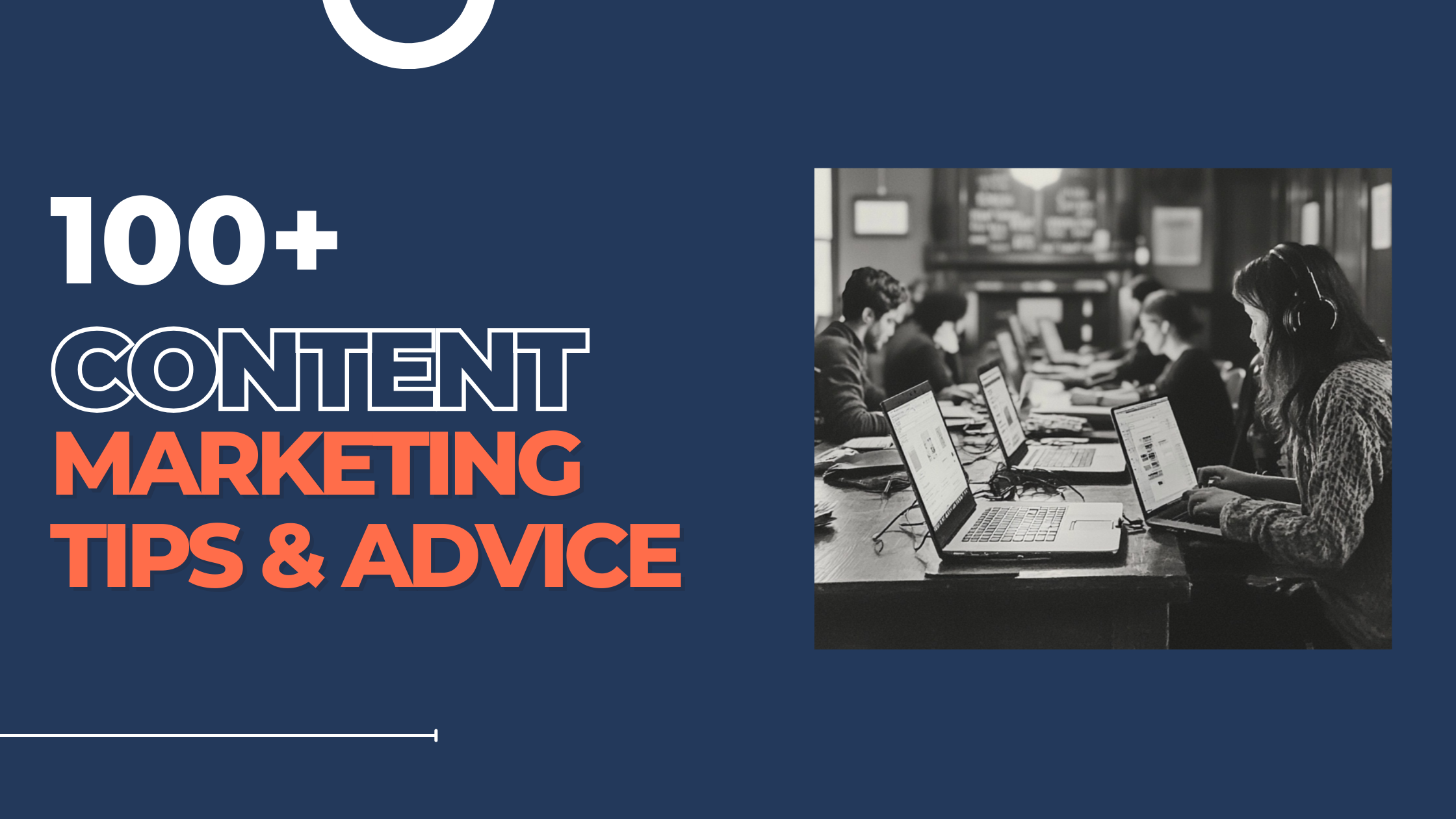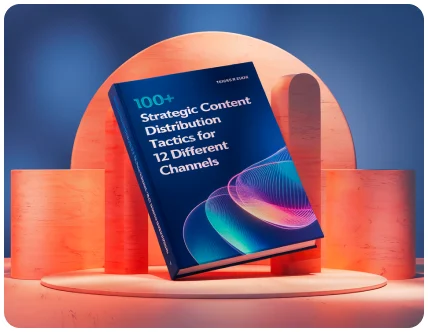100+ Content Marketing Tips for Engaging and Growing Your Audience
Great content doesn’t just sell—it connects, inspires, and builds trust. Yet, many brands miss the mark by creating without a strategy or audience insight. In this post, we’ll explore how to craft a results-driven content marketing plan, understand your audience, and create campaigns that captivate and convert. Turn content into your brand’s superpower.

Content marketing is the art of creating and sharing valuable content to attract and convert prospects into loyal customers. But here’s the truth—many brands pump out content that fails to resonate. Why?
Because they lack strategy, direction, or a deep understanding of their audience.
This post is packed with insights to help marketing professionals craft campaigns that actually engage, build trust, and grow an audience. From establishing a clear strategy to diversifying your content formats, you’ll discover actionable tips to make your efforts more impactful and rewarding.
Creating a Content Marketing Strategy: Why It Matters
Would you set sail on a ship without a map? Content marketing without a strategy is no different. A well-thought-out plan focuses your efforts, aligns your team, and ensures your content delivers real business results.
Start by asking yourself crucial questions like:
- What are we trying to achieve?
- Who are we speaking to?
- What problems are we solving for them?
A solid strategy puts purpose behind every blog, video, or post, ensuring your content earns its keep.
Understanding Your Audience: The Key to Engagement
The golden rule of content marketing: Know thy audience. If you skip this step, you’ll be left shouting into the void.
Take the time to research their demographics, pain points, and preferences. Tools like Google Analytics, social media insights, and surveys will reveal key details about their interests and behaviors.
Pro Tip: Use buyer personas to humanize your audience. Personas act as a visual representation of your target customers, making it easier to create content tailored to their unique needs.
Without audience understanding, content becomes noise. With it, your brand becomes a trusted voice.
Setting Clear Goals: Defining Success
Is your goal to drive website traffic? Generate leads? Increase engagement? Clarity here is everything—it dictates your content’s tone, format, and call to action (CTA).
For example:
- If the goal is brand awareness, focus on shareable assets like videos and infographics.
- For conversion-driven campaigns, produce case studies or free resources with strong CTAs.
When your goals are measurable (i.e., SMART goals—Specific, Measurable, Achievable, Relevant, Time-bound), your path to success becomes clear.
100 Content Marketing Tips For You To Steal
Here are a few highlights from 100+ actionable tips successful marketers swear by:
- Develop a documented content marketing strategy: Clearly outline your goals, target audience, and content distribution plans.
- Leverage AI tools for content creation: Use AI to assist in generating ideas, drafting content, and optimizing for SEO.
- Focus on quality over quantity: Prioritize creating valuable, in-depth content that addresses your audience’s needs.
- Optimize content for voice search: Structure content to align with conversational queries used in voice searches.
- Create interactive content: Engage your audience with quizzes, polls, and interactive infographics.
- Utilize video marketing: Incorporate videos to explain complex topics and showcase products or services.
- Implement a content repurposing strategy: Transform existing content into different formats to reach broader audiences.
- Invest in personalized content: Tailor content to individual user preferences and behaviors.
- Use data-driven insights: Analyze metrics to inform content topics and formats that resonate with your audience.
- Maintain a consistent publishing schedule: Regularly update your blog or content platforms to keep the audience engaged.
- Incorporate storytelling: Craft narratives that connect emotionally with your audience.
- Optimize for mobile users: Ensure content is accessible and visually appealing on mobile devices.
- Focus on user experience (UX): Design content layouts that are easy to navigate and read.
- Leverage social media platforms: Distribute content across channels where your audience is most active.
- Collaborate with influencers: Partner with industry influencers to expand your content’s reach.
- Implement SEO best practices: Use relevant keywords, meta descriptions, and backlinks to improve search rankings.
- Create pillar content and topic clusters: Develop comprehensive guides supported by related articles.
- Utilize user-generated content: Encourage and share content created by your audience.
- Conduct regular content audits: Evaluate existing content to identify gaps and opportunities for updates.
- Implement a content distribution plan: Strategize how and where to share content for maximum impact.
- Use compelling headlines: Craft attention-grabbing titles to increase click-through rates.
- Incorporate visual elements: Use images, infographics, and charts to enhance content engagement.
- Develop a content calendar: Plan and schedule content in advance to maintain consistency.
- Engage with your audience: Respond to comments and feedback to build community.
- Utilize email marketing: Distribute content through newsletters to nurture leads.
- Focus on niche topics: Address specific subjects to establish authority in your industry.
- Incorporate long-form content: Create detailed articles that provide comprehensive information.
- Use analytics tools: Monitor content performance to inform future strategies.
- Optimize content load speed: Ensure quick loading times to improve user experience.
- Implement content gating strategically: Use gated content to generate leads without deterring audience engagement.
- Leverage podcasts: Reach audiences through audio content on relevant topics.
- Create content for different stages of the buyer’s journey: Tailor content to address awareness, consideration, and decision stages.
- Utilize case studies: Showcase success stories to build credibility.
- Incorporate testimonials and reviews: Use social proof to enhance trust.
- Focus on evergreen content: Create timeless pieces that remain relevant over time.
- Use content to address customer pain points: Provide solutions to common challenges faced by your audience.
- Implement A/B testing: Experiment with different content formats and headlines to see what resonates.
- Leverage webinars and live sessions: Engage with your audience in real-time to provide value.
- Create a strong call-to-action (CTA): Guide your audience on the next steps to take.
- Utilize content syndication: Publish content on third-party platforms to reach new audiences.
- Incorporate humor where appropriate: Make content more relatable and shareable.
- Use data storytelling: Present data in a narrative format to make it more engaging.
- Focus on content accessibility: Ensure content is accessible to all users, including those with disabilities.
- Leverage content curation: Share relevant content from other sources to provide value.
- Implement a content approval process: Establish a workflow to maintain quality and consistency.
- Use emotional triggers: Appeal to emotions to connect with your audience.
- Incorporate FAQs into content: Address common questions to provide immediate value.
- Utilize content personalization: Use AI to deliver personalized content experiences.
- Stay updated with industry trends: Regularly research and adapt to changes in your industry.
- Use generative AI to test content variations: Quickly create and test multiple versions of headlines or copy.
- Focus on sustainability messaging: Highlight eco-friendly practices to attract environmentally conscious audiences.
- Collaborate with micro-influencers: Engage niche audiences through trusted, smaller influencers.
- Host virtual events and workshops: Use interactive sessions to showcase expertise and engage directly.
- Develop a unique brand voice: Stand out by maintaining a consistent and memorable tone across platforms.
- Leverage AR/VR in content: Use immersive technologies for storytelling and interactive experiences.
- Create “how-to” video series: Address common problems and establish authority.
- Experiment with AI-generated art: Use AI tools to create unique visuals for your campaigns.
- Build partnerships for co-branded content: Collaborate with complementary brands to reach new audiences.
- Run content contests: Encourage audience participation with creative challenges.
- Test interactive emails: Use embedded polls, quizzes, or games in email campaigns.
- Show behind-the-scenes content: Build authenticity by sharing your process or team stories.
- Leverage LinkedIn articles: Publish thought leadership content for B2B engagement.
- Create episodic content: Release content in a series to keep audiences coming back.
- Repurpose webinars into blogs and infographics: Maximize value from one-time events.
- Focus on local SEO: Optimize content for location-based searches.
- Create buyer persona-specific content: Tailor content to distinct audience segments.
- Highlight user success stories: Turn customer achievements into compelling case studies.
- Offer gated tools or templates: Share valuable, actionable resources behind a lead capture form.
- Test different posting times: Experiment with your publishing schedule for better engagement.
- Leverage social proof: Showcase awards, certifications, or customer reviews prominently.
- Create a content series with influencers: Develop recurring features with industry experts.
- Incorporate 360-degree videos: Give immersive experiences to showcase products or events.
- Run real-time polls on social media: Boost engagement while gathering audience insights.
- Use trending hashtags strategically: Tap into popular conversations to gain visibility.
- Leverage paid social ads for content promotion: Boost high-value posts to reach broader audiences.
- Launch a branded podcast: Share expertise and connect with audiences through regular episodes.
- Invest in premium tools for analytics: Gain deeper insights into audience behavior and content performance.
- Host live Q&A sessions: Address questions from your audience in real-time.
- Write contrarian thought pieces: Challenge conventional wisdom to stand out.
- Develop mobile-first content: Design content specifically for mobile consumption.
- Integrate chatbots for content suggestions: Provide tailored recommendations for visitors.
- Focus on “hub-and-spoke” content strategy: Build out related content around a core topic.
- Offer free courses or certifications: Create educational value to build authority.
- Use gamification in content: Add quizzes, leaderboards, or rewards to boost engagement.
- Create content summaries for social platforms: Adapt long-form content for short-form consumption.
- Develop niche newsletters: Cater to hyper-specific interests for better email engagement.
- Use data to create unique insights: Publish original reports based on proprietary research.
- Engage with online communities: Participate actively on Reddit, Discord, or niche forums.
- Test ephemeral content: Use stories or time-sensitive content to create urgency.
- Run UGC campaigns: Encourage users to share their own stories or experiences with your product.
- Collaborate with universities or experts: Enhance credibility with authoritative partnerships.
- Focus on content ROI tracking: Tie content efforts directly to measurable business outcomes.
- Optimize for zero-click searches: Structure content to appear in featured snippets.
- Publish thought-provoking questions: Spark conversation and engagement on social platforms.
- Create multilingual content: Expand reach by translating content for global audiences.
- Invest in AI-powered content audits: Use AI tools to identify performance gaps.
- Focus on diversity and inclusion in messaging: Ensure content reflects varied perspectives.
- Create hyperlocal content: Cater to the unique needs and interests of specific communities.
- Offer free consultations or demos: Use interactive sessions as lead magnets.
- Social Listening Engaging your audience begins with listening. Platforms like Twitter, Reddit, and industry-specific forums often contain unfiltered opinions and unmet needs.
Choosing the Right Content Types
Gone are the days of relying solely on blog posts. Today’s audience consumes information in diverse ways. Experimenting with content types keeps them engaged and broadens your reach.
Blogs
Blogs provide an opportunity to establish your expertise. Use them to tackle your audience’s most pressing questions and rank in search engines for greater visibility.
Videos
Did you know 91% of consumers prefer interactive and visual content? Videos can explain complex ideas in seconds while capturing your audience’s attention effortlessly.
Podcasts
Podcasts offer intimacy that other formats can’t match. Hearing a brand’s voice humanizes the experience, building deeper connections.
Infographics
Presenting data? Enter infographics. They condense complex information into easily digestible visuals, making them ideal for social sharing.
Pro Tip: Repurpose your content into multiple formats. A blog post can transform into a video, infographic, and social media snippets, expanding its impact.
Leveraging Data-Driven Insights
Data isn’t just numbers—it’s your best marketing ally. Back your strategy with insights, such as:
- Customer behavior trends
- Post click-through rates
- Conversion rates
Tools like Google Analytics and HubSpot provide deep insights into your content performance. Analyzing this data allows you to double down on what works and refine what doesn’t.
Consistent Publishing Schedule
Can you imagine waiting three months for the next episode of your favorite show? Neither can your audience. Consistency builds trust and keeps your audience coming back for more.
Create a content calendar to stay organized and align your publishing schedule with key dates and campaigns. If consistency feels overwhelming, start slow—quality over quantity is always better.
User-Generated Content (UGC): Harnessing the Power of Community
Getting customers involved in the content creation process is a win-win. UGC doesn’t just save resources; it makes your brand relatable and trustworthy.
Encourage customers to share their experiences using your products. Highlight their stories, reviews, or photos on your website and social media pages.
Did You Know? A study by Nielsen showed 92% of people trust recommendations from individuals (even if they don’t know them).
Personalization and Tailored Experiences
The one-size-fits-all approach doesn’t cut it anymore. Leveraging tools like personalized email marketing or dynamic website content ensures your message resonates with each audience segment.
For instance, if a visitor frequently reads your SEO articles, recommend downloadable guides or webinars tailored to SEO strategies.
Measuring Results and Pivoting when Needed
Content marketing doesn’t stop once you hit publish. Regularly measure your efforts using metrics like:
- Engagement (shares, likes, comments)
- Website traffic (page views, unique visitors)
- Conversion rates (downloads, leads captured)
Analyze what’s working and pivot your strategy where necessary. Agility is the secret weapon of any successful marketer.
Keep Experimenting, Keep Growing
Content marketing isn’t just about selling—it’s about connecting, educating, and building trust. By understanding your audience, diversifying your formats, and committing to consistency, your content strategy will thrive.
Are you looking to elevate your strategy even further? Sign up for our free webinar on mastering content creation. It’s packed with practical tips to boost engagement and build brand loyalty!

100+ Strategic Content Distribution Tactics For 12 Different Channels
The Distribution Playbook
Get the best in distribution advice delivered to your inbox.
Built to solve the distribution problem.Loved by marketers

Honestly, I thought ‘how much better than ChatGPT can it be?’ I’ve used chat to repurpose some work and while it works, it takes too much tweaking — especially with getting it to extract themes. Distribution.ai does a great job at sectioning the thoughts, creating punch copy, and I really liked the brand voice.
”Lily Ugbaja
Head of Content Marketing

We don’t have to spend hours writing episode descriptions any more. We can use this to craft all the copy we need to upload our podcast episodes
”A. Canta

We can now create 10 social media posts for clients in the matter of minutes. This AI is an absolute game changer.
”L. Henderson

We uploaded a blog post it created 10 social posts, we scheduled them over 3 months and the referral traffic skyrocketed.
”T. Perry